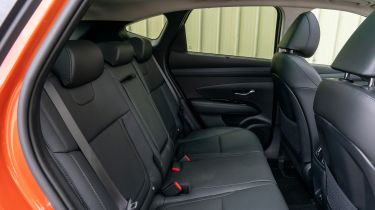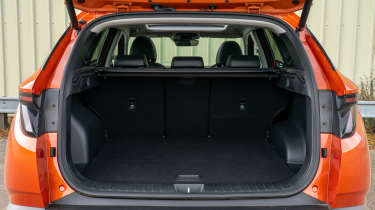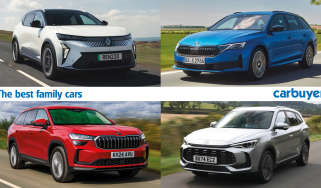Hyundai Tucson review - Practicality & boot space
An increase in size has improved passenger and luggage space
This current generation of Hyundai Tucson is 20mm longer, 15mm wider and 5mm taller than its predecessor, while the space between the front and rear wheels grew by 10mm. The last figure is particularly important, because while fitting bigger bumpers can make a car longer, its wheelbase usually dictates how much space is available for passengers.
Hyundai Tucson interior space & storage
Hyundai says there's 26mm more rear legroom in the latest Tucson, compared to the model that came before. In conventional and hybrid models alike, the battery was moved under the rear seats to improve packaging. The folding back seats have a 40:20:40 layout, which is another familiar trait of more expensive SUVs. This has the practical benefit of allowing two adults to sit either side of long items like skis or fishing rods, with the centre seat tipped forwards, and it’s a feature missing from the Renault Austral. The seats can be dropped by tugging levers just inside the boot or automatically in the N Line S and Ultimate version.
Boot space
Go for the Tucson Hybrid and boot space is up to 616 litres, while the mild-hybrid petrol has a smaller boot at 503 litres. The plug-in hybrid sits in between these with 558 litres of boot space. Fold the seats down in the Hybrid model and you’ll get 1,795 litres to play with, which will come in handy when you need to transport larger items like flatpack furniture or need to do a run to the tip.
Towing
The Hyundai Tucson can tow a braked trailer weighing up to 1,650kg, which matches the Toyota RAV4. However, the Volkswagen Tiguan can haul more, with a limit of 2,500kg for the 2.0-litre TDI with four-wheel drive.
Which Is Best?
Cheapest
- Name1.6T Advance 5dr
- Gearbox typeManual
- RRP£32,400
Most Economical
- Name1.6T Plug-in Hybrid Advance 5dr Auto
- Gearbox typeSemi-auto
- RRP£39,300
Fastest
- Name1.6T Plug-in Hybrid N Line 5dr Auto
- Gearbox typeSemi-auto
- RRP£41,800











